Economist, 10 July 1993, pp. 28-29; 2 April 1994, pp. 34-35; International Herald Tribune, 23 November 1993; Wall Street Journal, 17 May 1993, p. A7A.
Ira M. Lapidus, History of Islamic Societies (Cambridge, UK: Cambridge University Press, 1988), p. 3.
Mohamed Zahi Mogherbi, „Tribalism, Religion and the Challenge of Political Participation: The Case of Libya“, (доклад на конференция за демократичните предизвикателства в арабския свят, Кайро, 22–27 септември 1992), pp. 1, 9; Economist, (Survey of the Arab East), 6 February 1988, p. 7; Adlan A. El-Hardallo, „Sufism and Tribalism: The Case of Sudan“, (доклад на конференция за демократичните предизвикателства в арабския свят, Кайро, 22–27 септември 1992), р.2; Economist, 30 October 1987, p. 45; John Duke Anthony, „Saudi Arabia: From Tribal Society to Nation-State“, в Ragaei El Mellakh and Dorothea H. El Mellakh, eds., Saudi Arabia, Energy, Developmental Planning, and Industrialization (Lexington, MA: Lexington, 1982), pp. 93–94.
Yalman Onaran, „Economics and Nationalism: The Case of Muslim Central Asia“, Central Asian Survey, 13 (No. 4, 1994), 493; Denis Dragounski, „Threshold of Violence“, Freedom Review, 26 (March/April 1995), 12.
Barbara Daly Metcalf, „The Comparative Study of Muslim Societies“, Items, 40 (March 1986), 3.
Metcalf, „Muslim Societies“, p. 3.
Boston Globe, 2 April 1995, p. 2. 3a PAIC изобщо вж. „The Popular Arab and Islamic Conference (PAIC): A New ’Islamist International’?“ TransState Islam, 1 (Spring 1995), 12–16.
Bernard Schechterman and Bradford R. McGuinn, „Linkages Between Sunni and Shi’i Radical Fundamentalist Organizations: A New Variable in Middle Eastern Politics?“ The Political Chronicle, 1 (February 1989), 22-34; New York Times, 6 December 1994, p. 5.
Най-големият ислямски университет в света. — Б. пр.
Georgi Arbatov, „Neo-Bolsheviks of the I.M.F.“, New York Times, 7 May 1992, p. A27.
Схващания на севернокорейци, резюмирани от американски високопоставен политик, Washington Post, 12 юни 1994, p. CI; индийски генерал, цитиран в Les Aspin, „From Deterrence to Denuking: Dealing with Proliferation in the 199O’s“, Memorandum, 18 February 1992, p. 6.
Lawrence Freedman, „Great Powers, Vital Interests and Nuclear Weapons“, Survival, 36 (Winter 1994), 37; Les Aspin, Remarks, National Academy of Sciences, Committee on International Security and Arms Control, 7 December 1993, p. 3.
Цитирано в Stanley Norris, Boston Globe, 25 November 1995, pp. 1, 7; Alastair Iain Johnston, „China’s New ’Old Thinking’: The Concept of Limited Deterrence“, International Security, 20 (Winter 1995–96), 21–23.
Philip L. Ritcheson, „Iranian Military Resurgence: Scope, Motivations, and Implications for Regional Security“, Armed Forces and Society, 21 (Summer 1995), 575–576. Warren Christopher Address, Kennedy School of Government, 20 January 1995; Time, 16 December 1991, p. 47; Ali AI-Amin Mazrai, Cultural Forces in World Politics (London: J. Currey, 1990), pp. 220, 224.
New York Times, 15 November 1991, p. Al; New York Times, 21 February 1992, p. A9; 12 December 1993, p. 1; Jane Teufel Dreyer, „U.S./China Military Relations: Sanctions on Rapprochement?“ In Depth, 1 (Spring 1991), 17-18; Time, 16 December 1991, p. 48; Boston Globe, 5 Februaryl994, p. 2; Monte R. Bullard, „U.S.-China Relations: The Strategic Calculus“, Parameters, 23 (Summer 1993), 88.
Отбелязаните с апостроф доставки не са потвърдени.
Richard A. Bitzinger, „Arms to Go: Chinese Arms Sales to the Third World“, International Security, 17 (Fall 1992), p. 87; Philip Ritcheson, „Iranian Military Resurgence“, pp. 576, 578; Washington Post, 31 October 1991, p. Al, A24; Time, 16 December 1991, p. 47; New York Times, 18 April 1995, p. A8; 28 September 1995, p. 1; 30 September 1995, p. 4; Monte Bullard, „U.S.-China Relations“, p. 88, New York Times, 22 June 1995, p. 1; Gill, „Curbing Beijing’s Arms“, p. 388; New York Times, 8 April 1993, p. A9; 20 June 1993, p. 6.
John E. Reilly, „The Public Mood at Mid-Decade“, Foreign Policy, 98 (Spring 1995), p. 83; Executive Order 12930, 29 September 1994; Executive Order 12938, 14 November 1994. Същите тези са развити в Executive Order 12735, 16 November 1990, издаден от президента Буш и обявяващ извънредно положение по отношение на химическите и биологическите оръжия.
James Fallows, „The Panic Gap: Reactions to North Korea’s Bomb“, National Interest, 38 (Winter 1994), 40-45; David Sanger, New York Times, 12 June 1994, pp. 1, 16.
New York Times, 26 December 1993, p. 1.
Washington Post, 12 May 1995, p. 1.
Bilahari Kausikan, „Asia’s Different Standard“, Foreign Policy, 92 (Fall 1993), 28–29.
Economist, 30 July 1994, p. 31; 5 March 1994, p. 35; 27 August 1994, p. 51; Yash Ghai, „Human Rights and Governance: The Asian Debate“, (Asia Foundation Center for Asian Pacific Affairs, Occasional Paper No. 4, November 1994), p. 14.
Richard M. Nixon, Beyond Peace (New York: Random House, 1994), pp. 127–128.
Economist, 4 February 1995, p. 30.
Charles J. Brown, „In the Trenches: The Battle Over Rights“, Freedom Review, 24 (Sept./Oct. 1993), 9; Douglas W. Payne, „Showdown in Vienna“, ibid., pp. 6–7.
Charles Norchi, „The Ayatollah and the Author: Rethinking Human Rights“, Yale Journal of World Affairs, 1 (Summer 1989), 16; Kausikan, „Asia’s Different Standard“, p. 32.
Richard Cohen, The Earth Times, 2 August 1993, p. 14.
Гласуването в четирите кръга на изборите е както следва:
|
Първи кръг |
Втори кръг |
Трети кръг |
Четвърти кръг |
| Пекин |
32 |
37 |
40 |
43 |
| Сидни |
30 |
30 |
37 |
45 |
| Манчестър |
11 |
13 |
11 |
|
| Берлин |
9 |
9 |
|
|
| Истанбул |
7 |
|
|
|
| Въздържали се |
|
|
1 |
1 |
| Общо |
89 |
89 |
89 |
89 |
NewYorkTimes, 19 September 1993, p. 4E; 24 September 1993, pp. 1, B9, B16; 9 September 1994, p. A26; Economist, 21 September 1993, p. 75; 18 September 1993, pp. 37-38; Financial Times, 25–26 September 1993, p. 11; Straits Times, 14 October 1993, p. 1.
Читать дальше








